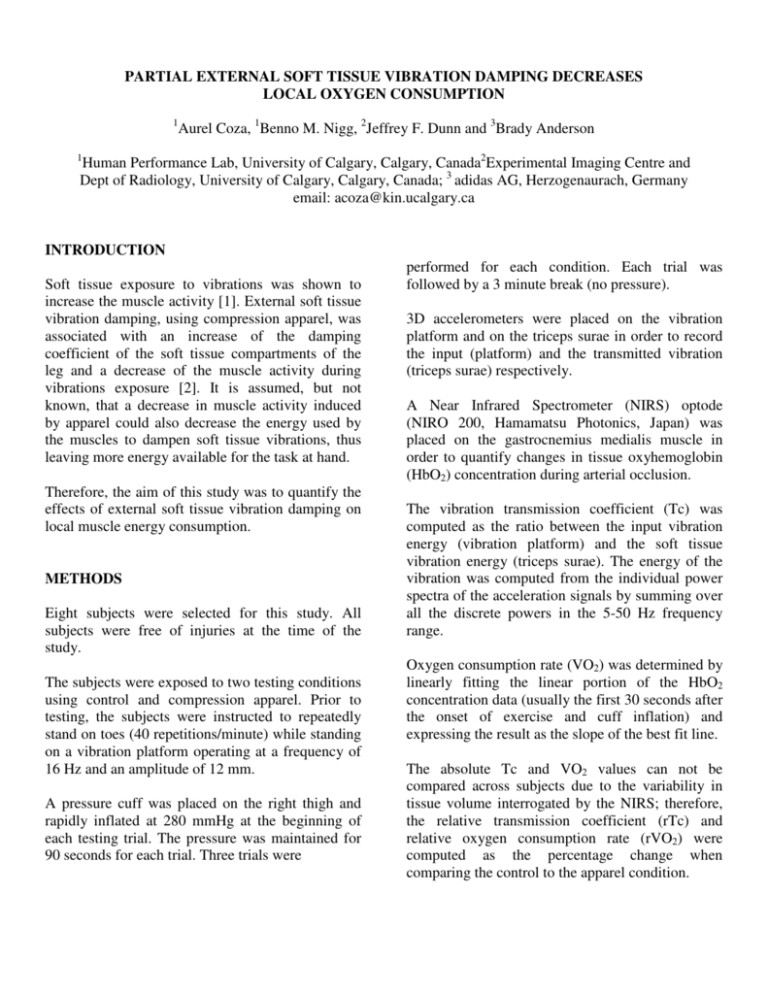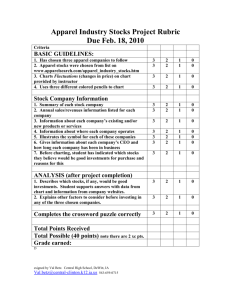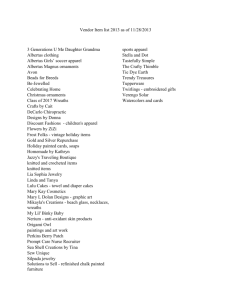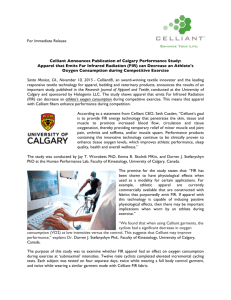1018
advertisement

PARTIAL EXTERNAL SOFT TISSUE VIBRATION DAMPING DECREASES LOCAL OXYGEN CONSUMPTION 1 Aurel Coza, 1Benno M. Nigg, 2Jeffrey F. Dunn and 3Brady Anderson 1 Human Performance Lab, University of Calgary, Calgary, Canada2Experimental Imaging Centre and Dept of Radiology, University of Calgary, Calgary, Canada; 3 adidas AG, Herzogenaurach, Germany email: acoza@kin.ucalgary.ca INTRODUCTION Soft tissue exposure to vibrations was shown to increase the muscle activity [1]. External soft tissue vibration damping, using compression apparel, was associated with an increase of the damping coefficient of the soft tissue compartments of the leg and a decrease of the muscle activity during vibrations exposure [2]. It is assumed, but not known, that a decrease in muscle activity induced by apparel could also decrease the energy used by the muscles to dampen soft tissue vibrations, thus leaving more energy available for the task at hand. Therefore, the aim of this study was to quantify the effects of external soft tissue vibration damping on local muscle energy consumption. METHODS Eight subjects were selected for this study. All subjects were free of injuries at the time of the study. The subjects were exposed to two testing conditions using control and compression apparel. Prior to testing, the subjects were instructed to repeatedly stand on toes (40 repetitions/minute) while standing on a vibration platform operating at a frequency of 16 Hz and an amplitude of 12 mm. A pressure cuff was placed on the right thigh and rapidly inflated at 280 mmHg at the beginning of each testing trial. The pressure was maintained for 90 seconds for each trial. Three trials were performed for each condition. Each trial was followed by a 3 minute break (no pressure). 3D accelerometers were placed on the vibration platform and on the triceps surae in order to record the input (platform) and the transmitted vibration (triceps surae) respectively. A Near Infrared Spectrometer (NIRS) optode (NIRO 200, Hamamatsu Photonics, Japan) was placed on the gastrocnemius medialis muscle in order to quantify changes in tissue oxyhemoglobin (HbO2) concentration during arterial occlusion. The vibration transmission coefficient (Tc) was computed as the ratio between the input vibration energy (vibration platform) and the soft tissue vibration energy (triceps surae). The energy of the vibration was computed from the individual power spectra of the acceleration signals by summing over all the discrete powers in the 5-50 Hz frequency range. Oxygen consumption rate (VO2) was determined by linearly fitting the linear portion of the HbO2 concentration data (usually the first 30 seconds after the onset of exercise and cuff inflation) and expressing the result as the slope of the best fit line. The absolute Tc and VO2 values can not be compared across subjects due to the variability in tissue volume interrogated by the NIRS; therefore, the relative transmission coefficient (rTc) and relative oxygen consumption rate (rVO2) were computed as the percentage change when comparing the control to the apparel condition. RESULTS AND DISCUSSION The HbO2 concentrations during the first 60 seconds after the onset of exercise for the apparel and control condition are shown in figure 1. The slopes for the apparel and control condition are distinguished. 100 Apparel Control HbO2 [%] 75 Since both the transmissibility coefficient and the oxygen consumption rate are a measure of the energy of the system, a linear relationship between the two is generally expected. However, the oxygen consumption rate seems to increase more rapidly than the transmissibility. 50 25 0 20 Time [s] 40 between the two variables (rTc and rVO2) indicates that the higher the external damping the higher the difference between the control and apparel oxygen consumption rate. Thus the apparel seems to decrease the oxygen consumption rate when compared to the control situation. Furthermore, the decrease in the oxygen consumption rate linearly correlates with the increase in the damping effects of the apparel. 60 Figure 1: Oxyhemoglobin concentration for the apparel and control condition during the first 60 seconds after the onset of exercise. A strong correlation (r2=0.84) between the relative oxygen consumption rate (rVO2) and the relative transmission coefficient (rTc) was observed (Fig 2). Extrapolating these results to a less controlled setup (e.g. running) one could expect that apparel can have an impact on the muscle energy consumption by means of external soft tissue vibration damping. However, this is a local effect and although this has the potential to locally decrease the oxygen consumption, the mechanisms involved in this process are not fully understood and require further investigation. CONCLUSION 15 This study has shown that: rVO2 [%] 20 10 5 0 4 8 12 16 (a) external damping of soft tissue vibrations (apparel) decreased the local oxygen consumption rate. (b) there is a linear relationship between the vibration energy transmitted to the muscles and the effect on oxygen consumption rate. rTc [%] Figure 2: Relative transmissibility factors (rTc) vs. relative oxygen consumption rate (rVO2) when changing from control to apparel condition. A higher rTc value means a larger difference between the Tc-control and Tc-apparel (i.e. high apparel damping effects). A higher rVO2 value represents a large difference between the VO2control and VO2-apparel (i.e. a lower oxygen consumption rate for the apparel condition compared to control). A positive correlation REFERENCES 1.Nigg, BM and Wakeling, JM Ex. and Sport Sci. Rev., 29(1): 37-41, 2001. 2.Coza A and Nigg BM, NACOB, Ann Arbor, MI, Abstract 253, 2008. ACKNOWLEDGEMENTS This study was financially supported by adidas AG and the da Vinci Foundation.






